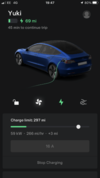Has Tesla slowed down Supercharger speeds for some reason? Or does the time of day effect speeds?
We take the same route from home to vacation home every 3 weeks or so. Obviously, our Model Y has us stop & charge at the same locations every time and the same locations going to and from. Typically we've charged 20-25 minutes in Metter, GA, but today it was 45 minutes. No other vehicles charging there so I don't believe it was some kind of sharing issue.
We take the same route from home to vacation home every 3 weeks or so. Obviously, our Model Y has us stop & charge at the same locations every time and the same locations going to and from. Typically we've charged 20-25 minutes in Metter, GA, but today it was 45 minutes. No other vehicles charging there so I don't believe it was some kind of sharing issue.



